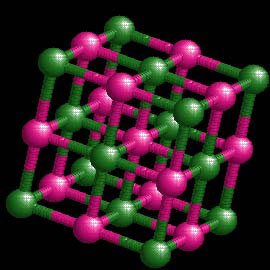Lab Activity 14: Using Red Cabbage to Identify Acids and Bases
Background:
Acids ionize in aqueous solution to produce hydronium ions (H3O+). The strength of an acid depends on the degree to which it ionizes. Strong acids ionize almost completely, while weak acids ionize to a lesser degree. Bases dissociate in aqueous solution to produce hydroxide ions (OH-). The properties of acids depend on the presence of free H3O+ ions as the predominant ion in a solution; and the properties of bases depend on the presence of free OH- ions as the predominant ion in a solution.
Well, acids react with hydroxide ions (OH-), which are produced by bases in aqueous solutions, to form water (H2O) and a salt.
| HCl |
+ |
NaOH |
->
|
NaCl |
+ |
H2O |
| Hydrochloric
Acid |
Sodium
Hydroxide (Base) |
Sodium
Chloride (Salt) |
Water |
This reaction is called a neutralization reaction (neutralizing the acid and base effect by producing H2O and a salt). A salt is an ionic crystalline compound. (Figure 1).
There is a measure of the strength of Acids and Bases called the pH scale. This scale ranges from 0-14 were the relative strengths of the acid or base are measured. The zero end indicates a strong acid and the 14 end indicates a strong base. Precisely in the middle, 7, indicates that the solution is neither basic or acidic, it's neutral. Therefore orange juice (pH=3.5) is a weaker acid than battery acid (pH=1.0). Get it?
| Indicators are used to
meaure the relative pH of solutions. I will prepare an idicator using
red cabbage leaves and distilled water (Procedures). By boiling the
cabbage leaves in water, we will extract the juices in the cabbage
and produce a purple solution that can be used to determine the relative
acidity/basicity of solutions. When the extractreacts with an acid
or base, it will change to a distinct color which you will observe.
Purpose: The purpose of this lab is to create an acid-base indicator and use it to determine the relative strengths of various common household substances. Also, by comparing the true pH (determined by you using a notebook computer and pH probe) and the colors you observe with the cabbage extract reactions, you will be required to create an indicator chart (color chart) to interperet the extract results. (see below) |
Figure 1: NaCl Salt. The purple atoms are sodium and the green ones are chlorine. Notice the crystalline (regular, repeating pattern) structure. |
Materials:
| •Red Cabbage | •Lemon Juice | •Seltzer | •100 ml beaker |
| •Ammonia | •20 ml Graduated Cylinder | •Pipette | •Laboratory Apron |
| •Bleach | •Draino | •Test tube X 11 | •Goggles |
| •Vinegar | •Soap solution | •Test tube rack | •Baking Soda solution (Sodium Bicarbonate) |
Safety:
Always wear safety goggles and a lab apron or coat when working in the lab.
Procedures:
Preparing the Red Cabbage Indicator: Obtain several leaves of red cabbage and 1 L of distilled water. Bring the water to a boil, add the cut-up leaves and mix well. Allow the solution to cool.
Part A
· Obtain 15 ml of each solution from beakers 1-3.
Using the computer and pH probe, determine the pH for the given solutions
and record your data in Table 1.
Part B
· Add 5-8 drops of cabbage extract to each of the test tubes in
Part A. In Table 1, record any changes
in color that may have occurred following the addition of the cabbage
extract.
Part C
· Select one of the household items from those available and add
approximately 15 ml of the solution to a separate test tube.
Add 5-8 drops of cabbage extract to the test tube.
Record any color changes in Data Table 2.
Estimate the pH of the item by comparing the color change observed with
those that were produced in Part A and Part B.
Repeat Part C for each household product.
Data Tables:
Table 1: pH Determination of Given Solutions
Given Solution |
pH as Determined by the Computer Probe |
Extract Color Change |
| Beaker 1 | ||
| Beaker 2 | ||
| Beaker 3 |
Table 2: pH Determination of Household Substances
Household Substance |
Extract Color Change |
Estimated pH |
Actual pH |
| Ammonia | |||
| Bleach | |||
| Vinegar | |||
| Soap Solution | |||
| Draino | |||
| Baking Soda Solution | |||
| Lemon Juice | |||
| Seltzer |
